Unlocking the Holiday Magic: Your Final Guide to Your DIY 3D Printed Lego Wreath
The holidays sparked innovation, integrating tradition with modern technology. What if you could combine the timeless charm of a wreath with the infinite creativity and nostalgic joy of Lego? enter 3D printed Lego wreath – A dazzling project that combines accessible digital manufacturing with a satisfying “click” of interlocking bricks. It’s not just decoration; it’s a personalized engineering feat for your door or wall! Whether you are an experienced manufacturer, LEGO enthusiast or a total 3D printing newbie, this guide will guide you through creating your own holiday masterpiece.
Why have 3D printed Lego wreaths?
- Unprecedented customization: Far beyond store purchases. Choose unique colors, integrate custom name tags, design professional decorations, and even copy the iconic LEGO scenes on any scale. Your creativity is the only limit.
- Durability and repeatability: Unlike natural leaves, a 3D printed Lego wreath does not wither. Secure it and reassemble it, year after year – a sustainable decor option.
- Perfect fit and precision: 3D printing ensures that LEGO-compatible studs are size-accurate, providing the perfect “clutch power” for a safe build. There are no strange connections here!
- Accessible and beneficial: With pre-designed files and any consumer FDM printer available today, the project is coming. The tangible result of turning digital design into physical decoration is incredible.
- Family entertainment: It is an engaging activity to work with your kids on solos and teach valuable skills in design, technology and problem solving.
Plan your masterpiece:
- Software and Design: Use any CAD software (Tinkercad is great for beginners) or modify an existing STL file from a repository like Thingiverse or Printables. Key elements:
- Basic wreath ring: It is usually a segmented circular structure with enough studs on the top and front to connect the decorative elements. Design of the build volume of printer.
- decorate: Think of holly leaves, snowflakes, stars, mini Christmas trees, gifts, LEGO statue platforms, personalized name patches, and even mini brick-built characters/vehicles. Integrate studs or technical pin holes on these bottoms for safe fixation.
- Color strategy: Decide your color palette! Print basic rings and key decor with main festive colors (classic LEGO red/green/gold? winter white/silver/blue? bold custom mix?). Contrast the layer of color accents. This is the most important thing to coordinate your filament selection.
Printing and Materials:
- Filigree selection: PLA It is the biggest competitor. It is affordable, easy to print, has bright colors, has low warping, and is very stiff and can be used on Lego. PETG offers slightly higher strength and heat resistance, but overhang and warping can be trickier. Avoid ABS due to warpage and smoke unless you have a dedicated housing and exhaust.
- Printer settings:
- nozzle: The standard 0.4mm nozzle is good in most decorative details. Larger nozzles (0.6mm) speed up printing of the base ring without significant loss of detail.
- Layer height: 0.15mm to 0.2mm can usually effectively balance details and printing time.
- filling: 15-25% of people are usually sufficient to perform structural integrity while preserving the filaments. Use denser fills (40%+) to get critical connection points or large clips (such as large clips). Mesh or capability patterns provide good strength to weight ratio.
- support: Necessary for features with huge overhangs (e.g., sloping ornaments, holly berries protruding from leaves). Use medium density and good interface settings for tree or normal support. Remove carefully!
- The most important thing is: dimension accuracy! For the perfect LEGO stud/connection, Calibrate your extrusion steps and flow rate carefully. Perform a small print test (such as a single 2×2 Lego layer – many files exist) to adjust until clutch power feels right. Slight compression may lead to loose fit; excessive repulsion makes it difficult for bricks to capture.
- optimization: Print flat elements as vertically as possible to maximize surface detail resolution on stud faces. Designed with hanging wood/gap connectors consistent with Lego tolerances. Oriental bending/basic part to minimize overhangs that need to be supported. Change the individual slice model of flexible colors if needed.
Rally: The fun part!
- Post-processing (pre-component):
- Use pliers and hobby knife carefully to remove the support material to avoid scarring to print the surface.
- Optional polishing/organization: Use fine sandpaper (e.g. 400+) to gently sand the rough spots (e.g., support contact areas) to make the feeling smoother. Sandpaper and fillers can be used to smooth the PLA. Advanced tips: Apply XTC-3D epoxy coating to glass-smooth LEGO-compatible surface (test on scrap sheet first!).
- clean: Wipe the debris with isopropanol to remove oil/fingerprints.
- put up: Like real Lego blocks, click on printed Lego elements to the basic wreath ring! remember:
- Symmetry and balance: Establish or connect decoration in a symmetrical visual harmony. If installed vertically, test the weight distribution.
- Layered: Add visual depth by layering smaller decorations on larger background elements.
- Safety: regular "squeeze" Assemble from the side to ensure the stud is fully involved.
Show your creations:
- Install: Fix a solid image hanging loop designed specifically for Lego blocks to the back stud of the garland. Alternatively, drill a small hole through one of a basic ring segments and loop around, ribbon or wire – make sure to keep it away from the pressure point.
- Indoor happiness: Hang proudly on your front door (free from extreme cold/sun) or indoors. Wreath shines with year-round wall art!
- Durability: Although PLA is powerful indoors, prolonged direct sun exposure can cause fading. Avoid areas close to large amounts of heat sources to prevent warping.
Conclusion: Beyond Decoration, Proof of Concept
Making a 3D printed Lego wreath is more than just creating holiday decorations. This is a happy exploration of the intersection of digital design, additive manufacturing precision and tangible games. It embodies how accessible 3D printing technology enables individuals to bring unique customization ideas to their lives with incredible details and features. You have designed a decor that is content with precision, customizes to your exact field of view, and designed to withstand the joyful season.
The same spirit of precise engineering, careful calibration and pushing the boundaries of custom manufacturing is the way to drive rapid prototyping in the industry. exist Greatyou apply for principles to ensure that perfect LEGO clutch capability resonates deeply with our core mission. Just as dimensional accuracy and material fit are crucial to your LEGO wreaths, they are the basis for creating functional, high-performance metal prototypes and end-use parts.
As a professional rapid prototyping manufacturer, Greglight Loveves cutting-edge selective laser melting (SLM) Metal 3D printers as well as a wide range of traditional machining functions. We not only solve complex prototype challenges; we provide Complete one-stop solution – From expert design consultation and optimized build preparation, through state-of-the-art additive manufacturing, precision CNC machining, heat treatment and fine finishes (shooting, polishing, polishing, anodizing, electroplating, vibration, vibration finishes).
Whether you need to use a conventional method, it is impossible to use complex geometry, use aluminum, titanium, stainless steel, tool steel, copper, nickel alloy or more metals, such as metals such as aluminum, titanium, stainless steel, tool steel, nickel alloy or more, for rapid iteration of design verification, or iterations. Greglight offers unparalleled quality and speed. We’re Precise rapid prototyping and custom machining ensures you get functional parts and are faster and more cost-effective in the highest standards.
Ready to turn your innovative concept into reality?
FAQ: Your 3D printed Lego wreath question has been answered
Q1: Do I need a very expensive 3D printer?
- one: Absolutely not! Any modern Fusion Deposition Modeling (FDM) printer with a heated bed and decent calibration will produce an excellent LEGO wreath. Popular consumer models like the Ender 3 or Prusa Mini level are the perfect starting point.
Q2: Can regular PLA work? Strong enough?
- one: Standard PLA is Recommended options For this project. It has excellent stiffness, is crucial to replicating the clutch power of the LEGO, is easy to print, and has endless colors. It is strong enough for decoration. If you are worried about the fact that PET will be stronger/sturdy in very cold climates outside.
Question 3: I don’t know about CAD. Can I make one more?
- one: really! Websites like Thingiverse and Printables feature many pre-designed LEGO wreath base rings and decorations. Search terms similar "Lego wreath," "Christmas wreath stand LEGO," or "Festive Lego decorations." You can download these STL files and print them directly and modify your collections annually using new decorations. Encourage learning the basics of Tinkercad!
Q4: Why are my printed Lego pieces not suitable? Too loose or too tight?
- one: It almost always comes down to Printer calibration:
- Loose fit: possible Inadequate sorting. Recalibrate your electronic steps and flow (many guides for calibration cubes). Consider printing at the lower end of the nozzle temperature range (stronger bonding). Enable "Horizontal hole expansion" In slicer (slight negative offset).
- Tight fit: possible Excessive exclusion. Recalibrate E steps and flow rate (reduce flow percentage). Enable "Horizontal hole expansion" There is a small Positive Value (for example, +0.05mm). Make sure that the filament diameter setting in the slicer is accurate. First print a simple test piece!
- one: It almost always comes down to Printer calibration:
Question 5: How long does the entire project take?
- one: This depends heavily on the complexity and size of the wreath, printer speed and post-processing. Start small! A simple bottom ring can take 8-12 hours. Decoration can range from 10 minutes to several hours. Assembly time (30 minutes to one hour). Countless nights in advance. Planning/find design and calibration is crucial.
Q6: Can I customize the size?
- Answer: Yes! This is one of the main advantages. In Slicer software, you can easily expand the downloaded STL file up and down, but please note:
- Zoom down Can make details more tricky to print and studs may be small in small amounts. Zoom up Thickened walls may require hollow/shell adjustments to save material/weight. It is best to find a ring size close to the desired final size.
- Answer: Yes! This is one of the main advantages. In Slicer software, you can easily expand the downloaded STL file up and down, but please note:
Q7: Can it be used outdoors?
- one: Although PLA is waterproof, UV light from direct sunlight Will be Degrade and fade its color and potentially become vulnerable over time. Moisture is not the main enemy; UV is. For outdoor displays, consider using higher wild type materials such as PETG or ASA, but even knowing that these materials will eventually disappear. Indoor display lifespan is highly recommended.
- Question 8: My complex decoration keeps failing. help!
- one: Supporting structures can be tricky. Solution:
- Repositioning: Rotate the model to minimize the dangling angles that need to be supported (e.g., print snowflakes vertically).
- Support settings: Slightly increase the support z-distance (0.18-0.22mm), reduce the support density, and ensure good interface layer clearance/mode. "The support of the tree" Generally, for organic shapes, less material is consumed and easier to remove.
- Simplified design: Can you redesign the decorations to be more independent? Can parts be printed and assembled separately?
- one: Supporting structures can be tricky. Solution:
Embrace the production spirit of the festival! Your personalized 3D printed Lego wreath is waiting. Remember, when your project requires metal industrial-grade precision Find your customized rapid prototyping and finishing solutions. Bring the most challenging design; experience innovation.





